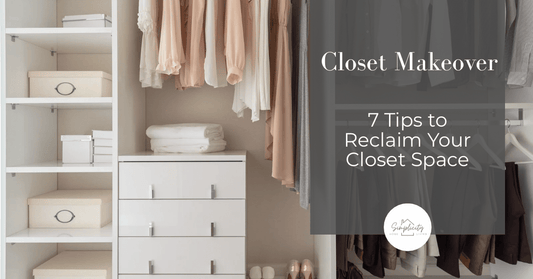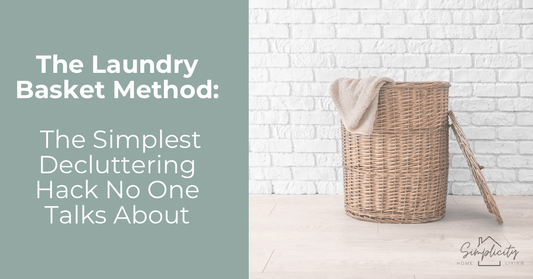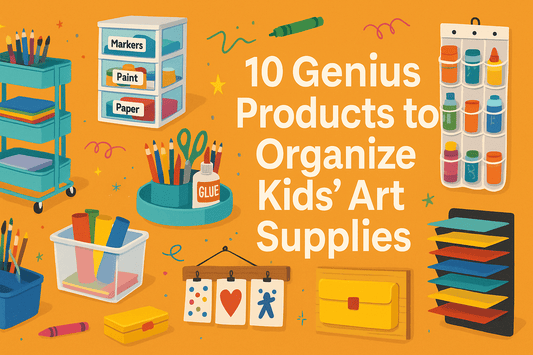“Cozy winter at home” shouldn’t feel like “we live in a toy store that exploded.”
Winter: The Season of Cozy… and Clutter
Winter looks so peaceful in photos: soft blankets, twinkle lights, beautiful Christmas trees, a candle flickering, kids quietly reading in a corner. In real life? Someone’s yelling for a snack, the living room looks like a Lego minefield, and outside is way too cold to burn off energy for more than ten minutes.
When the kids are stuck inside, everything gets used more: toys, crafts, blankets, dishes, your patience. Clutter piles up faster. The house feels smaller. And somehow, every room ends up with crayons, socks, and random things all over the floor.
The good news: you don’t need a bigger house or a personality transplant to stay on top of it. You just need a few simple systems that make winter life with kids feel more manageable, less messy, and a lot more peaceful.
Let’s talk about why winter multiplies the chaos—and the systems that can help your home survive it.
The Winter Parenting Struggle Is Real (Why Homes Get Messy So Fast)
Kids Are Inside 10x More
When the weather is nice, kids can take their energy (and half their toys) outside. In the winter, all that energy stays indoors. That means more toys out, more snacks, more crafts, and more “projects” that somehow involve tape on every surface.
Toys Multiply at an Alarming Rate
Winter usually comes right after the holidays, which means your home is already full of new toys, games, and gift sets. Old toys are still around, new toys are everywhere, and now you have 47 tiny playsets with 600 tiny pieces. Without a system, everything has equal opportunity to live on the floor.
Boredom = Rapid-Fire Messes
Bored kids don’t just pick one thing. They try all the things: puzzles, blocks, coloring, dress-up, crafts—often in the same 30-minute stretch. If there’s no plan, every activity leaves its mark, and by 3 p.m. it looks like you hosted a birthday party for 25 kids you’ve never met.
Parents Are Juggling Everything
On top of that, you’re working, cooking, doing laundry, running school schedules, and trying to remember which day is trash day. The clutter isn’t a sign you’re failing. It’s a sign that your home is doing a lot of heavy lifting—and it needs some systems to help it out.
So instead of trying to “just stay on top of it,” or let your kids just watch TV all day... let’s give your home (and your brain) some structure that actually works in winter.
Simple Systems That Make Winter Feel Manageable
1. The Daily Reset Basket System
What It Solves
Random toys, socks, books, and stuffed animals scattered across every room, especially the living room and hallway.
How It Works
- Give each child their own small basket or bin. You can also have one “family basket” for shared spaces.
- Throughout the day, anything that’s out of place gets tossed into the appropriate basket instead of left on the floor or counters.
- Once in the evening, do a single reset: kids take their baskets and put things back in their rooms or designated spots.
This turns “clean up the whole house” into “empty your basket.” Way less overwhelming for both parents and kids.
Why It Works in Winter: When the kids are home more, more stuff migrates into common areas. A daily reset basket keeps the clutter corralled instead of spread across three rooms.
2. The Indoor Activity Rotation System
What It Solves
Bored kids who dump every toy and activity they own in under an hour, then announce, “There’s nothing to do.”
How It Works
- Choose 5–7 “winter indoor activities” that your kids actually enjoy: building blocks, coloring, Play-Doh, puzzles, magnetic tiles, sticker books, simple craft kits, etc.
- Put each category in its own clear bin with a lid.
- Store the bins in a cabinet, closet, or cube shelf.
- Only one or two bins come out at a time. When kids are finished, that bin goes back before the next one comes out.
Activity Ideas to Rotate
- A craft bin with markers, crayons, glue sticks, and kid-safe scissors.
- A Lego or building block bin.
- A sensory bin or table with rice, scoops, and cups (or seasonal “snow” with cotton balls or kinetic sand).
- A puzzle bin with a few age-appropriate puzzles.
- A “quiet bin” with coloring books, stickers, and dot markers.
Take a look on Amazon and see if your kids would like any of their craft kits such as these!
Why It Works in Wintr: Instead of 47 toys out at once, you get one or two planned, contained activities. Less clutter, more focused play, and fewer “I’m bored” declarations.
3. The Cozy Winter Craft Station
What It Solves
Craft supplies taking over the dining table, kitchen counter, and occasionally the floor. Glitter appearing in rooms where glitter never should be.
How It Works
- Pick a spot for crafts: a corner of the dining room, a section of the playroom, or even a small wall in the kitchen.
- Use a rolling cart (we use this one), small bookshelf, or set of drawers as the “craft hub.”
- Sort supplies into categories: paper, coloring, paint, glue & tape, stickers, etc.
- Label each bin or drawer so kids know where things go back.
- Set a simple rule: crafts happen at a certain spot (table, mat, or tray), and supplies stay at the craft station unless an adult moves them.
Why It Works in Winter: Kids want “fun stuff” more often when they’re inside. A craft station gives them something creative to do, without crafts invading every flat surface in your house.
4. The Micro-Zones Layout (Winter Edition)
What It Solves
Kids wandering from room to room with toys, leaving a trail behind them because there isn’t a clear place to play or a clear place to put things back.
How It Works
You don’t need a giant playroom to make this work. Create a few small “zones” around your home that are clearly defined and easy to reset:
- Reading nook: A corner with a small basket of books, a beanbag chair or couple of pillows, and a cozy blanket.
- Building zone: A rug or mat where blocks, magnetic tiles, or Legos live.
- Quiet zone: A table or floor space for puzzles, board games, or quiet activities.
- Imagination zone: A bin or basket for dolls, action figures, toy cars, or pretend play.
Each zone gets its own storage: a bin, basket, or shelf that lives right there. When kids are done, everything goes back into that zone, not across the house.
Why It Works in Winter: Clear zones give kids a sense of “this is where we do this activity,” which makes it easier for them to clean up and for you to reset the house quickly.
5. The “Warm & Done” Winter Gear System
What It Solves
Hats, gloves, scarves, and random single mittens scattered everywhere from the front door to the living room.
How It Works
- Create a designated spot near the main door for all winter gear: a bench, small shelf, or set of hooks.
- Give each child a hook or two and a small basket, bin, or cubby for their hats and gloves.
- Use small drawer organizers or divided bins inside a larger basket to keep gloves and hats together.
- When kids come in, the routine is: coat on hook, boots in spot, hat and gloves in bin.
You can also keep a small laundry basket nearby for wet gear that needs to dry or go straight into the wash.
Why It Works in Winter: Winter clothing takes up space and gets used constantly. A simple system keeps it from ending up in random corners or getting lost every single morning.
Simple Winter Activities That Don’t Wreck the House
Because sometimes you need quick, low-mess ideas that don’t involve turning your living room into a craft crime scene.
- No-mess painting books (water reveal books are perfect for little ones).
- Sticker activity books for quiet, table-friendly fun.
- Magnetic tiles that can be quickly scooped into a bin.
- Puzzles with a designated puzzle mat or board.
- Indoor scavenger hunts using things you already own.
- Simple sensory bins with rice, beans, or cotton balls and a few scoops.
Browse low-mess kids' activities and puzzle sets on Amazon
Bonus Quick Tips to Stay Sane All Season
- Keep a “donate” bag handy: When new toys arrive or your kids outgrow things, drop items in the bag right away.
- Use a 10-minute reset after dinner: Quick pick-up, quick vacuum, everyone helps, then move on.
- Set up a kid snack station: A small bin or drawer with approved snacks so you’re not constantly playing “snack concierge.”
- Rotate weekly: Pull out a fresh stack of books or toys for the reading nook or play area to keep things interesting without buying more.
Winter Doesn’t Have to Feel Like Just Surviving
Winter with kids can absolutely feel like a lot. More mess, more noise, more stuff everywhere—and fewer chances to escape outside. But a few simple systems can completely change how your home feels.
You don’t need to overhaul your entire house. Start small:
- Give each kid a daily reset basket.
- Set up a simple activity rotation with a few clear bins.
- Create one tiny craft corner or reading nook to make winter feel a little more cozy and a little less chaotic.
Your home doesn’t have to be perfect to feel peaceful. With a few routines and some smart storage, it can be a place where your kids can play, create, and make memories—without you feeling like you’re drowning in clutter every single day.
Try one of these systems this week, and see how much lighter winter at home can feel.










